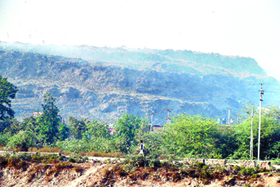The solid wastes of Delhi, the largest municipal solid waste generator in the country with a production of about 7000 metric tonnes a day is dumped at three landfill sites, namely Bhalaswa, Ghazipur and Okhla. The increasing quantity of solid wastes is a matter of concern and studies indicate that solid waste disposal does not generally take proper care for the protection of surrounding environment.
Bhalaswa landfill site in north eastern Delhi spread over 21.06 acres of land came into operation in 1993. The landfill site is located near the Bhalaswa Lake, which is a fresh water oxbow lake on Yamuna floodplain. This area also houses the Bhalaswa resettlement colony that has a population of more than 4000 households, consisting of people who were displaced from various regions of Delhi and then resettled there by the government around eleven years ago.

‘A myth of a land’: Bhalswa resettlement colony dwellers are demanding freehold rights.
Image courtesy: Jiby Kattakayam, The Hindu
The Bhalaswa Lok Shakti Manch and Hazards Centre conducted a study recently to assess the potability of the groundwater from the pumps located in areas that surround the Bhalaswa landfill site, like the Bhalaswa resettlement colony, Shraddhanand colony, and Mukundpur, Nathupura and Nanglipuna. Surveys were done to find out about the general health of the sample population. A total of 877 people were interviewed. The idea was to understand the relationship between the quality of groundwater and the general health of the population.
The major source of drinking water in Bhalaswa is the water supplied by DJB through public stand posts (88 per cent), which is supplemented by hand pumps when this water is not available. Each house has a hand pump that they use mainly for domestic chores, however occasionally, they use it for drinking purposes also, when they do not have access to the other types of drinking water.
During the survey, people were asked about the visible characteristics of the water that they receive. A large number of people reported problems such as not obtaining clear water, but getting coloured water having sediments. The people reported that on letting the water stand for some time, a layer of sediments is observed at the bottom. In some of the hand pumps near the landfill, the water that comes out sometimes is brownish‐blackish in colour.
Additionally, according to data from the Central Ground Water Board and the Central Pollution Control Board, groundwater in Bhalaswa is fresh water up to 30m‐60m depth. However, 94 per cent of the respondents said that the drinking water is salty in taste. Even in Shraddhanand colony, 77 per cent of the respondents and in Munkundpur‐Nathupura 87 per cent of the respondents said that the drinking water is saline.
In addition, groundwater samples were taken in November 2010 by random sampling from handpumps and bore wells located near the landfill site, and the quality of groundwater was analysed by various tests. The sites were chosen in a radial direction in the north and east sides and at increasing distances from the landfill. On the western and southern sides, the landfill is bordered by a drain. Various parameters of the samples such as pH, total dissolved solids (TDS), chemical oxygen demand (COD), heavy metals such as lead, zinc, chromium and presence of faecal coliforms were tested.
The study revealed that the groundwater from the hand pumps located in the vicinity of the landfill show increased concentrations of contaminants. The water samples had high levels of TDS, COD as well as specific contaminants such as lead and zinc. Some of the water samples were faecally contaminated.
This indicates that there is a possibility of contamination occurring due to the landfill. In the hand pump samples in the resettlement colony, each of the four samples had higher TDS than the maximum permissible limit (BIS) and three of the four samples were faecally contaminated. One of the samples had TDS value 6205 ppm, three times higher than the maximum permissible limit of 2000 ppm (BIS). Each of the samples had COD, two of them having a COD of 82.72 and 75.2 ppm. Thus the groundwater available to the residents of the resettlement colony was unfit for human consumption. However, due to the lack of piped water supply or regular tanker water supply, the residents are forced to use this impure water.
The residents suffer from a number of illnesses, especially gastro‐intestinal diseases, musculoskeletal pain, skin and eye irritation, and respiratory problems. For example, 79 per cent of the sample population of Bhalaswa resettlement colony suffers from different types of stomach problems, including 31.9 per cent females and 21.1 per cent males who complained of diarrhoea and vomiting.
Some blocks had especially greater problems, and the groundwater in the region also was not good. This indicates that the groundwater in the area around the landfill is being contaminated due to leachate from the landfill, and additionally as there is no regular provision of clean drinking water in the colony, the people have to suffer.
Regular contact with the polluted groundwater for use in domestic chores such as bathing, washing utensils and clothes has also led to a large number of people suffering from skin irritation, itching and eye irritation. Landfill leachate has presence of contaminants such as benzene, toluene, ethylbezene that cause problems such as eye and skin irritation. In addition, the location of the colony being so near the landfill also exposes the population to harmful landfill gases such as benzene, ethylbenzene, acrylonitrile, carbon disulphide, etc., which have impacts on the respiratory system and eyes.
This study is indicative, and there is a need to carry out a more detailed study, with a larger number of samples. Steps have to be taken to ensure a clean water supply to the residents, and also to ensure that the landfill does not lead to further contamination of the groundwater. The landfill is nearing its closure date, and it should be capped properly.
/articles/residents-bhalaswa-resettlement-colony-new-delhi-facing-risks-due-groundwater